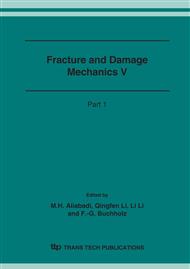p.651
p.655
p.659
p.663
p.667
p.671
p.675
p.679
p.683
Application of the GTN Model to Quantify Constraint Effects on Ductile Fracture of API X65 Steels
Abstract:
This paper quantifies the effects of geometry, the loading mode and the specimen size on fracture toughness of the API X65 steel, via plane strain finite element (FE) damage analyses using the GTN model. The validity of FE damage analyses is checked first by comparing with experimental test data for small-sized, cracked bar test. Then the analyses are extended to investigate the effects of the relative crack depth and the specimen size on fracture toughness. It is shown that fracture toughness of the API X65 steel increases with decreasing the relative crack depth and increasing the specimen size.
Info:
Periodical:
Pages:
667-670
Citation:
Online since:
November 2006
Authors:
Keywords:
Price:
Сopyright:
© 2006 Trans Tech Publications Ltd. All Rights Reserved
Share:
Citation:


